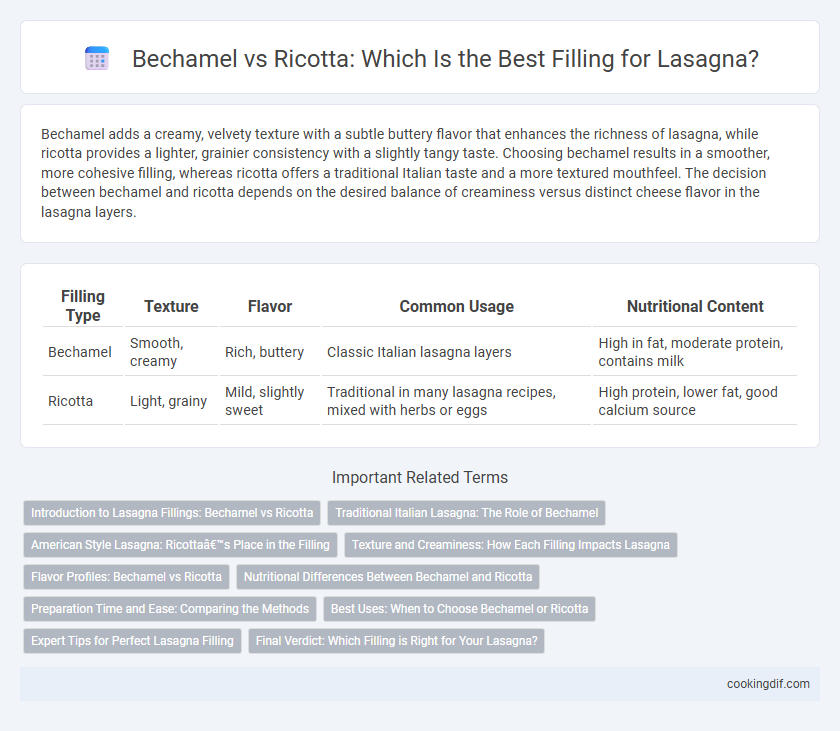Bechamel adds a creamy, velvety texture with a subtle buttery flavor that enhances the richness of lasagna, while ricotta provides a lighter, grainier consistency with a slightly tangy taste. Choosing bechamel results in a smoother, more cohesive filling, whereas ricotta offers a traditional Italian taste and a more textured mouthfeel. The decision between bechamel and ricotta depends on the desired balance of creaminess versus distinct cheese flavor in the lasagna layers.
Table of Comparison
| Filling Type | Texture | Flavor | Common Usage | Nutritional Content |
|---|---|---|---|---|
| Bechamel | Smooth, creamy | Rich, buttery | Classic Italian lasagna layers | High in fat, moderate protein, contains milk |
| Ricotta | Light, grainy | Mild, slightly sweet | Traditional in many lasagna recipes, mixed with herbs or eggs | High protein, lower fat, good calcium source |
Introduction to Lasagna Fillings: Bechamel vs Ricotta
Bechamel sauce, a creamy mixture of butter, flour, and milk, provides a smooth, rich texture that enhances the layers of traditional Italian lasagna. Ricotta cheese offers a lighter, slightly grainy consistency with a mild tang, often combined with herbs and eggs to create a filling that balances richness and flavor. Choosing between bechamel and ricotta influences the overall mouthfeel and taste profile, with bechamel delivering a velvety base and ricotta contributing a fresh, creamy element.
Traditional Italian Lasagna: The Role of Bechamel
Traditional Italian lasagna relies heavily on bechamel sauce for its creamy texture and rich flavor, creating a smooth layering that perfectly complements the meat and pasta sheets. Unlike ricotta, which can be grainy and dense, bechamel provides a velvety consistency essential in classic recipes such as Lasagna alla Bolognese. The bechamel's subtle buttery notes and ability to bind ingredients make it the preferred filling in authentic Italian kitchens.
American Style Lasagna: Ricotta’s Place in the Filling
American style lasagna traditionally features ricotta cheese in the filling, providing a creamy texture and mild flavor that complements the tomato sauce and meat layers. Ricotta's high moisture content helps create a rich, cohesive structure, whereas bechamel offers a smoother, more velvety consistency often favored in Italian regional variations. This preference for ricotta enhances the hearty, rustic character typical of American lasagna recipes, making it a staple ingredient in the filling.
Texture and Creaminess: How Each Filling Impacts Lasagna
Bechamel sauce contributes a smooth, velvety texture with a creamy consistency that binds the layers of lasagna seamlessly, enhancing its moistness without overpowering other ingredients. Ricotta cheese offers a thicker, slightly grainy texture that adds a richer, indulgent creaminess while providing a more substantial bite to each layer. Choosing between bechamel and ricotta fillings directly influences the overall mouthfeel, with bechamel delivering a silkier finish and ricotta creating a heartier, textured experience.
Flavor Profiles: Bechamel vs Ricotta
Bechamel sauce offers a creamy, buttery texture with subtle nutmeg undertones that enrich lasagna layers without overpowering other ingredients. Ricotta cheese provides a tangy, slightly grainy flavor that adds a fresh, light contrast to hearty tomato sauces and savory meats. Choosing between bechamel and ricotta depends on the desired balance of richness and tanginess, shaping the overall taste experience of the lasagna.
Nutritional Differences Between Bechamel and Ricotta
Bechamel sauce, made from butter, flour, and milk, is higher in carbohydrates and fats compared to ricotta cheese, which offers more protein and calcium while being lower in calories. Ricotta contains essential nutrients like phosphorus and vitamin A, supporting bone health and immune function, whereas bechamel provides more saturated fats due to added butter. Choosing ricotta for lasagna filling enhances protein content and micronutrient intake, making it a healthier alternative for balanced nutrition.
Preparation Time and Ease: Comparing the Methods
Bechamel sauce requires more preparation time due to the need for careful stirring and gradual incorporation of milk to achieve a smooth texture, while ricotta filling is quicker to prepare, often needing only simple mixing with eggs and seasoning. The ease of preparing ricotta filling makes it ideal for home cooks seeking a straightforward lasagna assembly, whereas bechamel demands more attention to prevent lumps and achieve the desired creaminess. Choosing between bechamel and ricotta impacts both cooking duration and technique complexity, influencing the overall lasagna preparation workflow.
Best Uses: When to Choose Bechamel or Ricotta
Bechamel sauce, with its creamy texture and subtle flavor, is best suited for classic Italian lasagna recipes like Lasagna alla Bolognese, where it adds richness and binds meat and pasta layers smoothly. Ricotta cheese provides a thicker, slightly grainy texture and mild tang, ideal for vegetarian or lighter lasagna varieties incorporating spinach or vegetables, offering a more textured filling. Choose bechamel for a velvety, smooth consistency in traditional meat-based lasagna, while ricotta works best when a firmer, creamier filling is desired in vegetable or cheese-forward lasagna dishes.
Expert Tips for Perfect Lasagna Filling
For a creamy, rich lasagna filling, bechamel sauce offers a smooth texture that evenly binds the layers, enhancing moisture without overpowering other ingredients. Ricotta cheese, with its grainy texture and mild tang, provides a lighter, slightly drier filling that complements hearty sauces and robust flavors. Experts recommend using bechamel for traditional Italian lasagna to achieve a classic silky finish, while ricotta works best in rustic or lighter versions, often combined with herbs and egg for added structure.
Final Verdict: Which Filling is Right for Your Lasagna?
Bechamel sauce offers a creamy, smooth texture with a subtle buttery flavor that enriches traditional Italian lasagna, ideal for those seeking a classic, velvety filling. Ricotta cheese provides a lighter, slightly grainy consistency packed with protein, which contributes a fresh tang and pairs well with vegetable or meat layers for a more textured bite. Choosing between bechamel and ricotta depends on preferred richness and texture: bechamel suits a luscious, silky lasagna, whereas ricotta works best for a lighter, more rustic dish.
bechamel vs ricotta for filling Infographic

 cookingdif.com
cookingdif.com